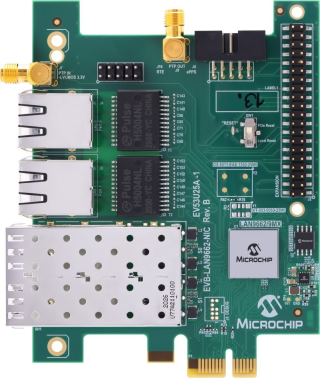LAN966x
1. LAN966x Family overview
The LAN966x family comprises the following SoCs:
-
LAN9662 - 2 port end-node TSN Gigabit Ethernet switch device.
-
LAN9668 - 8 port TSN Gigabit Ethernet switch device.
2. Memory map
When dealing with low-level SW, it is piratical to know the physical hardware addresses of the memory-mapped areas. The table below show the relevant areas. Please note that off-chip resources such as flash and DDR, depends on board design, be sure to check the schematics.
Name On-Chip Start Max size Size eval board ======= ======= ========== ==================== =================== BOOTROM Yes 0x00000000 0x00014000 (80KB) 0x00014000 (80KB) SRAM Yes 0x00100000 0x00020000 (128KB) 0x00020000 (128KB) QSPI0-NOR No 0x20000000 0x10000000 (256MB) 0x2000000 (2MB) DDR No 0x60000000 0x80000000 (2048MB) 0x80000000 (2048MB)
3. EVB Overview:
This chapter describes the different LAN966x Reference Boards. All examples assume that there is a working TFTP and DHCP server on the same subnet.
3.1. EVB-LAN9668
This is the 8 port eval board using the LAN9668 SoC.
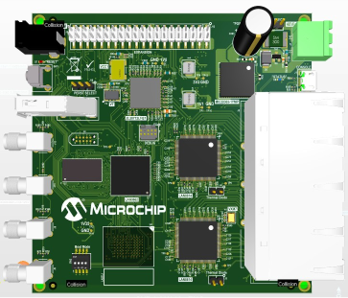
This PCB has the following features:
-
LAN9668 switch device
-
SST26VF016B SPI NOR boot flash
-
4GB eMMC NAND flash
-
512MB DDR3L-1333 x16 RAM (Optional 1GB or 2GB)
-
2x LAN8814 (Indy) quad 1000BASE-T PHY
-
USB 2.0 device
-
Local management via USB port
-
Power from either 12V or 48V DC
From a software perspective there is only one difference compared with the EVB-LAN9662 board.
3.2. EVB-LAN9662
This is the 2 port eval board using a LAN9662 SoC.
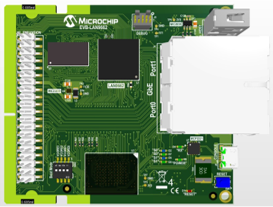
This PCB has the following features:
-
LAN9662 switch device
-
SST26VF016B SPI NOR boot flash
-
4GB eMMC NAND flash
-
512MB DDR3L-1333 x16 RAM (Optional 1GB or 2GB)
-
2x 1000BASE-T ports using internal LAN9662 PHYs
-
USB 2.0 host
-
Local management via USB port
-
Power from either USB port or expansion connector
3.4. EVB-LAN9662-Carrier
This is a carrier board used together with UNG_8291 to expose more interfaces and functionality.
If higher performance is needed, UNG_8309 supports mounting a Raspberry Pi 4 Compute Module to be used as an external CPU system.
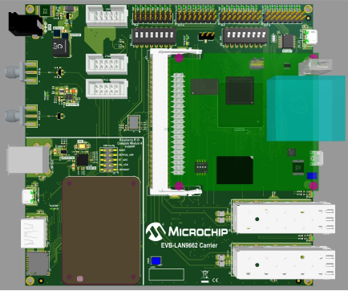
3.5. EVB-LAN9668-EDS2
This PCB has the option to plug different PHY modules boards. Meaning that it can support a different number of ports depending on the inserted PHY modules. It can have up to 8 ports including the 2 internal PHYs.
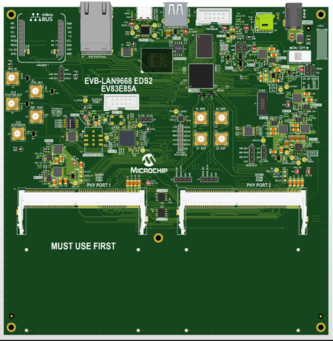
It has the following features:
-
LAN9668 switch device
-
SST26VF016B SPI NOR boot flash
-
4GB eMMC NAND flash
-
512MB DDR3L-1333 x16 RAM (Optional 1GB or 2GB)
-
2x 1000BASE-T ports using internal LAN9662 PHYs
-
USB 2.0 device
-
Local management via USB port
-
Power from either 12V or 48V DC
4. Board Name Overview
The name used in the device trees for the Linux Kernel is the internal product name, as this has been created at a very early stage of the project.
To allow you to move between the different names that are in use, you can use the table found below:
| Internal Board Name | Board Order No | Board Name |
|---|---|---|
UNG8290 |
EV18W53A |
EVB-LAN9668 |
UNG8291 |
EV09D37A |
EVB-LAN9662 |
UNG8314 |
EV53U25A |
EVB-LAN9662-NIC |
UNG8309 |
EV44Z97A |
EVB-LAN9662-Carrier |
UNG8385 |
EV83E85A |
EVB-LAN9668-EDS2 |
